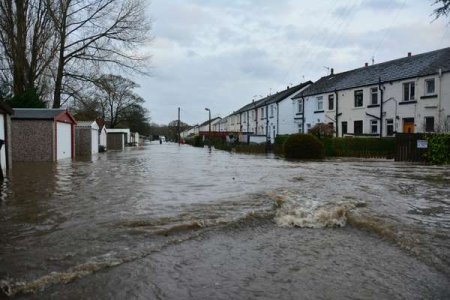Rain is coming—Here’s how to stay safe when it pours
- Replies 0
As the skies darken and the forecast turns grim, the threat of heavy rainfall and potential flooding looms large.
In an era where climate change is intensifying weather patterns, the risk of severe storms and the subsequent flooding is a growing concern, especially for those who have cherished homes filled with memories and valuables.
But fear not, dear readers of The GrayVine, for there are proactive steps you can take to shield yourself, your home, and your belongings from the wrath of Mother Nature.
The key to weathering any storm is preparation. Long before the rain begins to pour, it's crucial to assess your home's resilience.
Are you up to code? Does your insurance policy cover flood damage? These are the questions that need answers well in advance.
Addressing any vulnerabilities early can save you a world of trouble when disaster strikes.

Stay Informed and Alert
As a storm approaches, staying informed is your first line of defense. Sign up for real-time weather alerts from city, county, and federal agencies.
Keep your radio tuned to the latest news and heed the advice of local officials. Knowledge is power, and in this case, it could very well be the power to save your life and property.
Property Protection Tactics
There are practical measures you can take to minimize damage. Ensure that your gutters, storm drains, and stormwater systems are free of debris and functioning properly. These simple acts can significantly reduce the risk of water buildup around your home.
Sandbags can be a homeowner's best friend in a flood scenario. When used correctly, they form a barrier that can redirect or block incoming water. Learn how to properly fill and stack sandbags to create an effective floodgate.
Evacuation vs. Sheltering in Place
When local authorities issue an evacuation order, it's imperative to follow it. Prepare a kit with important documents, ensure your vehicle has a full tank of gas, and be ready for the possibility of an extended absence from home.
However, there comes a time when it's safer to stay put than to brave the storm-tossed roads. Flooded streets can be deceptive, hiding deep waters and strong currents capable of sweeping away even the sturdiest of vehicles.
Source: The Ismaili USA / Youtube.
Home and Belonging Safeguards
In the face of an imminent flood, move your treasured items, furniture, and electronics to higher ground within your home.
Check that your sump pump is operational and its backup battery is fully charged. Stock up on essentials like food, water, and medications. If you have a car, park it on higher levels of a parking structure to avoid water damage.
Also read: Brace yourself! Extreme storms are sweeping the nation—are YOU in the danger zone?
And remember, common sense is your ally. Don't store backup generators or other critical equipment in areas prone to flooding, like basements.
Responding to the Disaster
If you find yourself caught off-guard by a flood, seek the highest safe point in your home or find a secure shelter.
However, if high winds and tornadoes are also a threat, being on higher levels could be risky. Always stay tuned to the latest forecasts to make informed decisions.
Read next: The truth about how weather affects our mental health—Here’s what experts have to say

Have you tried and tested methods for weathering the storm? Share your own experiences with storm preparation, ask questions, or offer advice to fellow readers in the comments below!
In an era where climate change is intensifying weather patterns, the risk of severe storms and the subsequent flooding is a growing concern, especially for those who have cherished homes filled with memories and valuables.
But fear not, dear readers of The GrayVine, for there are proactive steps you can take to shield yourself, your home, and your belongings from the wrath of Mother Nature.
The key to weathering any storm is preparation. Long before the rain begins to pour, it's crucial to assess your home's resilience.
Are you up to code? Does your insurance policy cover flood damage? These are the questions that need answers well in advance.
Addressing any vulnerabilities early can save you a world of trouble when disaster strikes.

Extreme weather events, including heavy rainfall leading to flooding, are becoming more frequent with climate change, posing various dangers. Image source: Chris Gallagher / Unsplash.
Stay Informed and Alert
As a storm approaches, staying informed is your first line of defense. Sign up for real-time weather alerts from city, county, and federal agencies.
Keep your radio tuned to the latest news and heed the advice of local officials. Knowledge is power, and in this case, it could very well be the power to save your life and property.
Property Protection Tactics
There are practical measures you can take to minimize damage. Ensure that your gutters, storm drains, and stormwater systems are free of debris and functioning properly. These simple acts can significantly reduce the risk of water buildup around your home.
Sandbags can be a homeowner's best friend in a flood scenario. When used correctly, they form a barrier that can redirect or block incoming water. Learn how to properly fill and stack sandbags to create an effective floodgate.
Evacuation vs. Sheltering in Place
When local authorities issue an evacuation order, it's imperative to follow it. Prepare a kit with important documents, ensure your vehicle has a full tank of gas, and be ready for the possibility of an extended absence from home.
However, there comes a time when it's safer to stay put than to brave the storm-tossed roads. Flooded streets can be deceptive, hiding deep waters and strong currents capable of sweeping away even the sturdiest of vehicles.
Source: The Ismaili USA / Youtube.
Home and Belonging Safeguards
In the face of an imminent flood, move your treasured items, furniture, and electronics to higher ground within your home.
Check that your sump pump is operational and its backup battery is fully charged. Stock up on essentials like food, water, and medications. If you have a car, park it on higher levels of a parking structure to avoid water damage.
Also read: Brace yourself! Extreme storms are sweeping the nation—are YOU in the danger zone?
And remember, common sense is your ally. Don't store backup generators or other critical equipment in areas prone to flooding, like basements.
Responding to the Disaster
If you find yourself caught off-guard by a flood, seek the highest safe point in your home or find a secure shelter.
However, if high winds and tornadoes are also a threat, being on higher levels could be risky. Always stay tuned to the latest forecasts to make informed decisions.
Read next: The truth about how weather affects our mental health—Here’s what experts have to say
Key Takeaways
- Extreme weather events, including heavy rainfall leading to flooding, are becoming more frequent with climate change, posing various dangers.
- Experts emphasize the importance of disaster preparation and good planning, including ensuring homes meet building codes and understanding insurance coverage.
- In anticipation of storms, it's crucial to stay informed through weather alerts, clear drainage systems, and properly use sandbags if necessary, while considering evacuation orders seriously.
- To safeguard homes and belongings from floodwaters, moving items to higher ground, checking sump pump batteries, and planning sensibly for emergencies are recommended steps, along with seeking higher ground or shelter if caught unprepared.
Have you tried and tested methods for weathering the storm? Share your own experiences with storm preparation, ask questions, or offer advice to fellow readers in the comments below!






